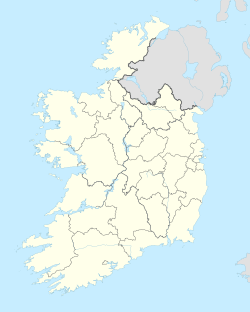Rath Turtle Moat facts for kids
|
Ráth Torcaill
|
|
| Alternative name | Rathturtle Moat |
|---|---|
| Location | Deerpark, Blessington, County Wicklow, Ireland |
| Region | Wicklow Mountains |
| Coordinates | 53°10′46″N 6°33′28″W / 53.179395°N 6.557808°W |
| Altitude | 286 m (938 ft) |
| Type | ringwork |
| Length | 49 m (161 ft) |
| Width | 36 m (118 ft) |
| Area | 0.55 ha (1.4 acres) |
| History | |
| Builder | Anglo-Normans |
| Material | earth |
| Founded | 12th century AD |
| Cultures | Anglo-Norman |
| Site notes | |
| Ownership | private |
| Official name | Rathturtle |
| Reference no. | 662 |
Rath Turtle Moat is an ancient site in County Wicklow, Ireland. It is a special type of old fort called a ringwork. Today, it is protected as a National Monument, which means it's an important historical place.
A ringwork is a circular or oval-shaped fort built from earth. It has a raised area in the middle, surrounded by a high bank and a ditch. These forts were often used for defense a long time ago.
Contents
Where is Rath Turtle Moat Located?
Rath Turtle Moat is found in Glen Ding Wood. This spot is about 1.6 kilometers (1 mile) northwest of Blessington. It sits high up, looking over the River Liffey reservoir. The site is also close to where the Morell River begins.
The History of Rath Turtle Moat
This ancient site gets its name from a powerful family called the Meic Torcaill. They were a leading Norse-Gaelic family in Dublin during the 12th century. Norse-Gaelic means they had both Viking (Norse) and Irish (Gaelic) roots.
Later, the area came under the control of the Normans. The Normans were people from Normandy, France, who conquered England in 1066. They began to take over parts of Ireland in the 12th century.
Why Were Ringworks Built?
Ringworks like Rath Turtle Moat were built during the early stages of the Norman conquest of Ireland. They were simple but strong forts. They helped the Normans protect their new lands.
These forts usually had a wooden gate tower. This tower would have been the main entrance. The path leading into the fort, called a causeway, was often lined with stone. The high earthen banks around the fort were topped with a wooden palisade. A palisade is a fence made of strong wooden stakes, used for defense.
What Does Rath Turtle Moat Look Like?
Rath Turtle Moat has an oval shape. It features a raised central area. This area is surrounded by a tall earthen bank. Outside this bank, there is a deep ditch, also known as a fosse. Beyond the ditch, there is another outer bank.
The main entrance to the fort is on the south side. To get across the ditch and into the fort, there is a causeway. This causeway acts like a bridge over the ditch.


